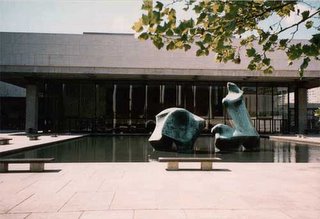While I unfortunately will not be at this evening's world premiere of Tobias Picker's "An American Tragedy", with a libretto by Gene Scheer based upon Theodore Dreiser at the Metropolitan Opera in New York City (I plan to catch it later), I did attend, last night, an advance screening of Steven Spielberg's "Memoirs Of A Geisha", based upon Arthur Golden's bestselling novel from early 1999. [I consulted for the research and art departments of DreamWorks SKG in the late 1990s.]
I will only say that I found this latest Spielberg film to be superbly acted by an international Asian cast, sensitively directed by Rob Marshall, and with beautiful art direction and musical values. John Williams was commissioned for the score, which he provided in between his scores for the Spielberg films "War of the Worlds" and "Munich". The score features Western instruments, Japanese instruments such as shakuhachi and koto, and solos by both frequent William's collaborators Yo-Yo Ma, and, to a slightly lesser degree, Itzhak Perlman. The score sounded beautiful over the National Geographic Society's state of the art sound system in its modest sized theater. Film music expert Dan Goldwasser walks the listener through extended excerpts from the new John Williams score at:
http://www.soundtrack.net/features/article/?id=167
One final comment. The audience at the screening largely consisted of representatives of the Japanese and Chinese embassies and staff members of the National Geographic Society. The average age of this highly educated audience was, I would guess, about 30 to 35; or younger than the 35 to 45 age group which is the new target audience for the American Symphony Orchestra League and Opera America classical music outreach efforts.
And in the small world department, I happened to sit next to a young couple who came down from Baltimore for the screening: the Mongolian woman from Ulan Bator was fluent in English, Russian, and Japanese, and her boyfriend was Danish and had studied in Vilnius, Lithuania. They had attended the wedding last Spring of a former house-mate of mine who married a Danish woman (a wedding which I was invited to, but missed having been in Ukraine). This couple were also subscribers to the Baltimore Opera company!
Please also see: http://www.anamericantragedy-theopera.org/
and
"Talking About Picker’s An American Tragedy" two-CD set:
http://www.metoperafamily.org/shop/display.aspx?ID=9462

Dazaifu Tenmangu, a large shrine that is home to a God of learning, in Fukuoka, Japan. (Large parts of Spielberg's film were shot in Northern California.)
"Dazaifu City is home to several historical sites that attract tourists year-round, including Dazaifu Tenmangu, a large shrine that is home to a God of learning, and the ruins of the ancient seat of government built 1300 years ago. Dazaifu takes on a new identity with every season, thrilling visitors with its verdant summers, red autumns and white winters. The leaves are now turning a brilliant red, a color that fits perfectly with its ancient roots. The leaves blend harmoniously with the ancient buildings that surround Tenmangu Shrine, giving visitors the illusion of entering a different world.
Among these sites, Komyozenji, a temple known for its lichen and stone garden, offers unforgettable autumn scenery. Located near Dazaifu shrine, Komyozenji was founded as a Zen temple in 1273 by Buddhist priest Tetsugyu Enshin of the Rinzaishu Tofuku Sect. Its exquisitely set lichen and stone garden are enveloped in a deep silence. Ittekikainoniwa, a display of lichen and white sand symbolizing the land and sea, and the Fukkosekitei, a stone arrangement of the kanji character for Òlight,Ó will fill you with a deep sense of inner peace before the beautiful stillness of ancient Japan."
Text and photo credit: www.fukuoka-now.com










































